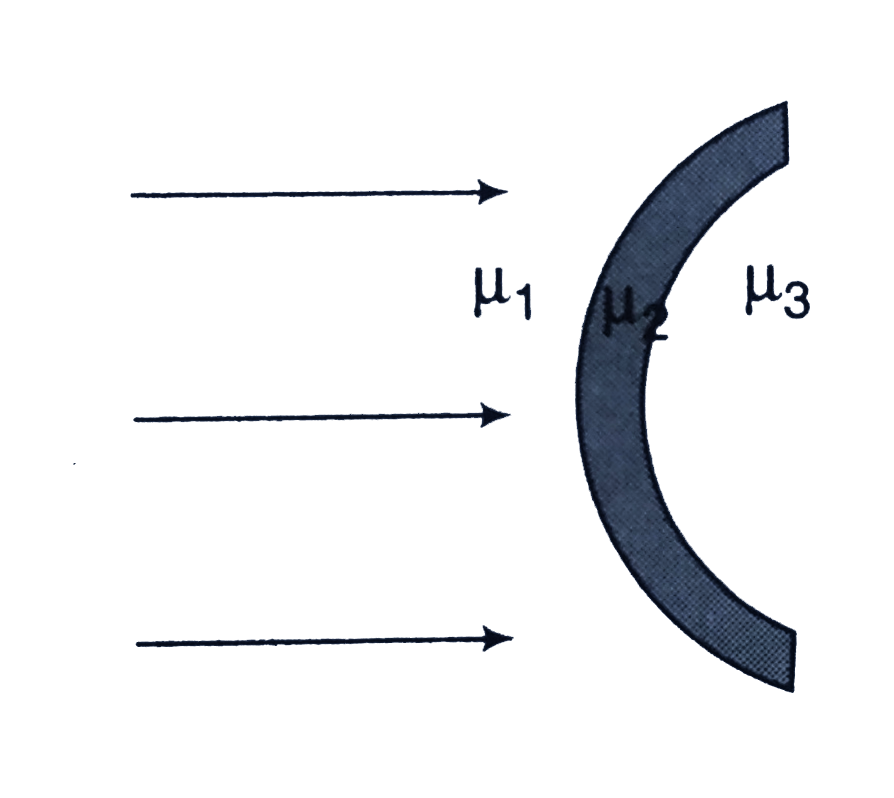Two identical thin isosceles prisms of refracting angle A and refractive index μ are placed with their bases touching each other and this system can collectively act as a crude converging lens. A parallel beam of light is incident on this system as shown in Figure. Find the focal length of this so called converging lens.

Since tanδ=hf⇒f=htanδ
Further, δ=(μ−1)A⇒f=h(μ−1)A

Topper's Solved these Questions
- GEOMETRICAL OPTICSBOOK - CENGAGE PHYSICSCHAPTER - GEOMETRICAL OPTICSEXERCISE - Exercise1.5
22 Videos
- GEOMETRICAL OPTICSBOOK - CENGAGE PHYSICSCHAPTER - GEOMETRICAL OPTICSEXERCISE - Exercise1.6
15 Videos
- GEOMETRICAL OPTICSBOOK - CENGAGE PHYSICSCHAPTER - GEOMETRICAL OPTICSEXERCISE - Exercise1.3
25 Videos
- FRICTIONBOOK - CENGAGE PHYSICSCHAPTER - FRICTIONEXERCISE - QUESTION BANK
1 Videos
- GRAVITATIONBOOK - CENGAGE PHYSICSCHAPTER - GRAVITATIONEXERCISE - Question Bank
39 Videos
Similar Questions
Two identical thin isosceles prims of refracting angle θ and refractive index μ are placed with their bases touching each other. A parallel beam , of width 2b, is incident on this system , as shown. The distance of the point of convergence from the prism is

View SolutionA converging beam of light rays incident on a glasa-air interface as shown in figure. Find where these rays will meet after refraction.

View Solution
Knowledge Check
Two isosceles prism of prism angle A and refractive index μ are placed with their bases touching each other. This system can act as a crude converging lens. The focal length of the lens for A=10∘,μ=1.5 and a ray of light incident on a prims at a height of 1 cm from its base, is approximately.
 A11.5 cmB23.0cmCzeroD5.75cm
A11.5 cmB23.0cmCzeroD5.75cmTwo converging lenses of focal lengths f1=10cm and f2=20cm are placed at some separation. A parallel beam of light is incident on first lens. Then,
Afor emergent beam form second lens to be parallel, the separation between the lenses has to be 30cmBfor emergent beam from second lens to be parallel, the separation between the lenses has to be 60cmCif lenses are placed at such a separation that emergent beam from second lens is parallel, then the emergent beam width is 2cm if original beam has a width of 1cmDif lenses are placed at such a separation that emergent beam from second lens is parallel, then the emergent beam width is 4cm if original beam width is 1cm.
A double convex lens made of a material of refractive index μ1, is placed inside two liquids of refractive indices μ2 and μ3 as shown (μ1>μ2>μ3) A wide parallel beam of light is incident on the lens from the left. The lens will give rise toAa single convergent beamBtwo different convergent beamsCtwo different divergent beamsDa convergent and a divergent beam
In the figure, light is incident on a thin lens as shown. The radius of curvature for both the surfaces is R. Determine the focal length of this system.

View SolutionImage formation by a system of thin prism and lens
A beam parallel to the principal axis is incident on a thin prism (Fig. 34-60). Find the location of final image.
View SolutionA thin converging lens made of glass of refractive index 1.5 acts as a concave lens of focal length 50cm, when immersed in a liquid of refractive index 15/8. Calculate the focal length of converging lens in air.
View Solution
An isosceles prism of angle 120degree has a refractive index 1.44. Two parallel monochromatic rays enter the prism parallel to each other in air as shown. The rays emerge from the opposite faces
View SolutionA double convex lens, lens made of a material of refractive index μ1, is placed inside two liquids or refractive indices μ2 and μ3, as shown. μ2>μ1>μ3. A wide, parallel beam of light is incident on the lens from the left. The lens will give rise to

View Solution
